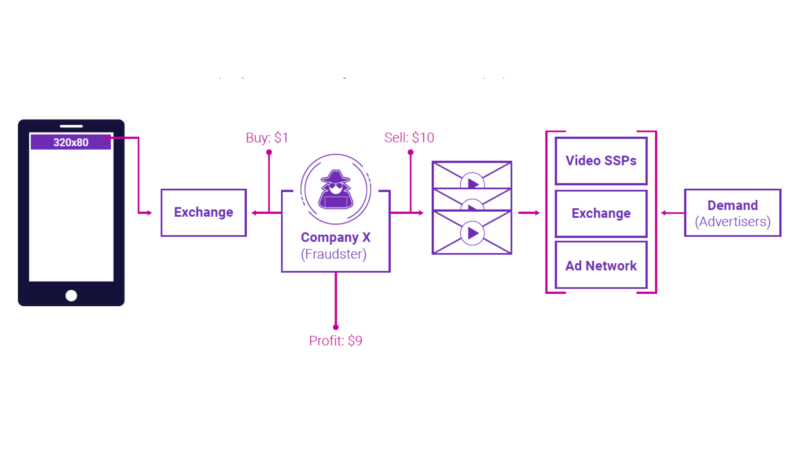Mobile app ad fraud scheme stuffed banner ads with multiple video players
Sold as premium inventory, the scheme resulted in two million fraudulent ad calls per day, said DoubleVerify.

DoubleVerify’s explanation of how bad actors resold in-banner ads as premium inventory.
A mobile app ad fraud scheme involving banner ads being resold as premium video ad inventory on Android devices has turned up.
How the scheme worked. Using a sophisticated process, the bad actors purchased banner impressions and resold them as premium in-stream video ad inventory. To further profits, the schemers then stuffed the ad units with multiple video players.
“Instead of just one video player, multiple players are called in an attempt to pull ads in parallel from multiple sources,” said DoubleVerify, which reported the scheme. In one instance, the company found as many as eight concurrent players in one ad slot.
“Various player sizes are depicted to maximize revenue, regardless of the size of the original ad slot. Often the original ad slot is just 320 x 50 — but the players are much larger and the ad content cannot be viewed.”
The video player is also configured to remove sound and play controls so the viewer cannot stop the ad from playing.
The impact. The ad fraud scheme generated an estimated two million ad calls a day, according to DoubleVerify. The report did not include specific dollar amounts, but Asaf Greiner, CEO of Protected Media, told BuzzFeed a similar ad fraud scheme costs advertisers tens of millions of dollars per month.
Users hit by the scheme saw phone battery life and bandwidth drained because the video ads played in a forced, unstoppable loop.
DoubleVerify said the viewability rate for ads associated with this scheme was less than two-percent. The ad verification platform said it flagged the ad servers connected to the scheme and marked the connected domains as Ad Impression Fraud. It also worked with affected partners to end the source of traffic.
Why you should care. Mobile app ad fraud continues to be a problem, estimated to cost advertisers $5 billion in 2018. Mobile in-app IVT rates rose to 23 percent in the last quarter of 2018, up from 17 percent the previous quarter, according to a Pixalate report.
In October, the Coalition Against Ad Fraud released its “Definitions of Mobile Fraud Schemes” — a standardized document to define mobile ad fraud and counter any misinformation connect to fraudulent schemes or practices. Earlier this month, the IAB Tech Lab released the final version of its app-ads.txt specifications, an extension of the ads.txt file designed to support apps distributed through mobile and OTT app stores.
Opinions expressed in this article are those of the guest author and not necessarily MarTech. Staff authors are listed here.
Related stories